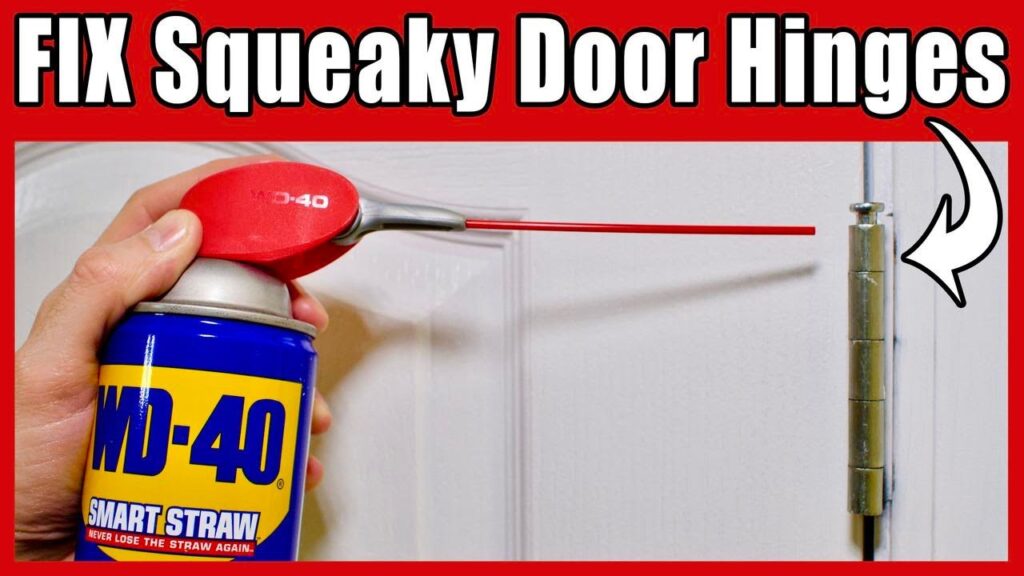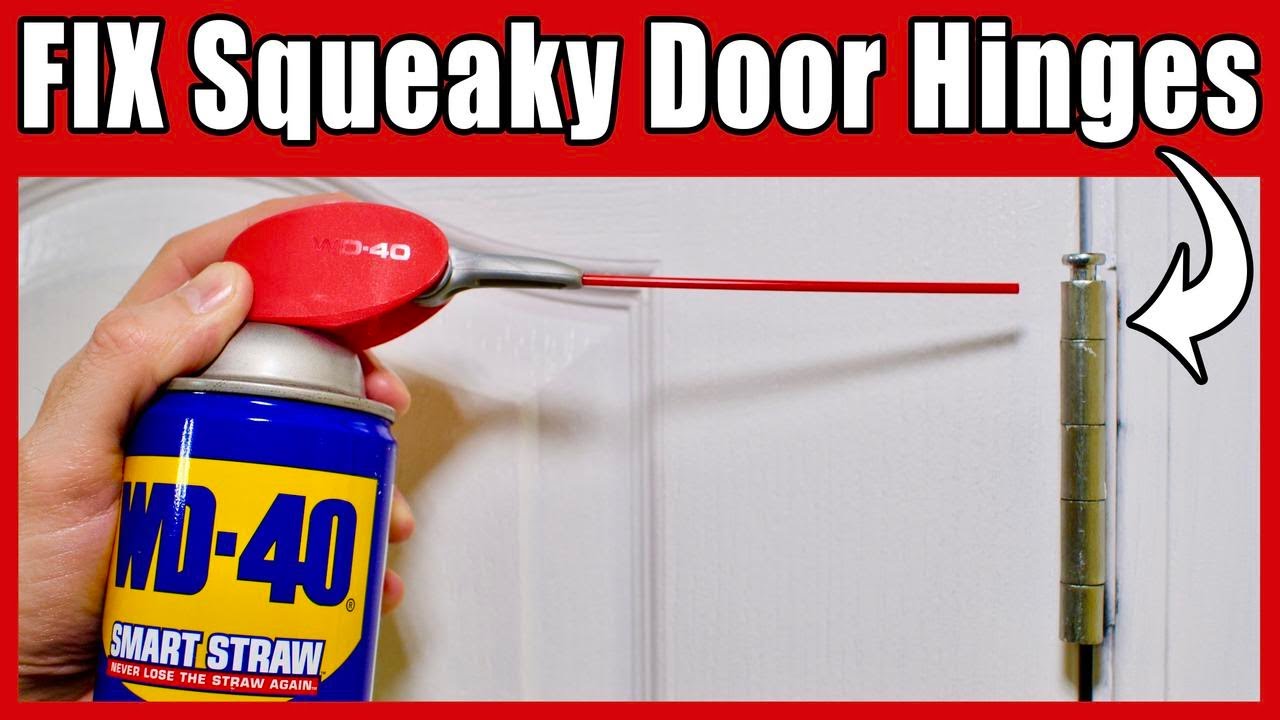
WD-40 for Squeaky Doors: A Practical Guide to Silencing Annoying Hinges
That persistent squeak every time you open or close a door can drive anyone up the wall. It’s a common household annoyance that disrupts the peace and quiet. While there are various solutions available, WD-40 for squeaky doors is often the first thing that comes to mind for many homeowners. But is it the best solution? This article dives deep into using WD-40 to tackle those pesky squeaks, exploring its pros, cons, application techniques, and alternative solutions to help you make an informed decision.
Understanding the Squeak: Why Doors Squeak
Before reaching for the WD-40, it’s helpful to understand why doors squeak in the first place. The primary culprit is friction. Over time, the lubricant in door hinges dries out, leading to metal-on-metal contact. This friction generates the irritating squeaking sound. Other contributing factors include:
- Lack of Lubrication: As mentioned, old or insufficient lubricant is a common cause.
- Rust and Corrosion: Rust can build up on the hinge pins, increasing friction and causing squeaks.
- Loose Hinges: Loose screws can cause the door to shift, putting extra stress on the hinges and leading to squeaking.
- Dirt and Debris: Dust, dirt, and other debris can accumulate in the hinges, contributing to friction.
WD-40: The Quick Fix for Squeaky Doors?
WD-40 is a widely recognized name, synonymous with household problem-solving. It’s often touted as a universal solution for everything from loosening rusty bolts to displacing moisture. When it comes to WD-40 for squeaky doors, it can provide temporary relief. The formula’s lubricating properties can reduce friction and silence the squeak, at least for a short period.
The Pros of Using WD-40
- Accessibility: WD-40 is readily available at most hardware stores, home centers, and even grocery stores.
- Ease of Use: It’s incredibly simple to apply. The spray nozzle allows for targeted application to the hinges.
- Quick Results: WD-40 often provides immediate relief from the squeaking sound.
- Multi-Purpose: You likely already have a can of WD-40 in your garage or toolbox, making it a convenient option.
The Cons of Using WD-40
While WD-40 offers a quick fix, it’s essential to understand its limitations. The primary drawback is that it’s not a long-term solution. Here’s why:
- Not a True Lubricant: WD-40 is primarily a water displacement product and a solvent. While it does have some lubricating properties, it’s not designed to be a long-lasting lubricant.
- Dries Out Quickly: WD-40 tends to evaporate quickly, meaning the squeak will likely return sooner rather than later.
- Can Attract Dust and Dirt: The residue left behind by WD-40 can attract dust and dirt, which can actually worsen the problem over time.
- Potential Damage to Finishes: In some cases, WD-40 can damage certain door finishes or paints.
How to Apply WD-40 to a Squeaky Door
If you choose to use WD-40, here’s how to apply it effectively:
- Preparation: Place a cloth or paper towel beneath the hinges to catch any drips.
- Application: Use the spray nozzle to apply WD-40 directly into the hinge joints. Focus on the areas where the metal parts rub together.
- Work it In: Open and close the door several times to work the WD-40 into the hinges.
- Wipe Away Excess: Use a clean cloth to wipe away any excess WD-40 that drips or sprays onto the door or frame.
- Repeat if Necessary: If the squeak persists, repeat the application process.
Better Alternatives to WD-40 for Squeaky Doors
For a more lasting solution, consider using a dedicated lubricant specifically designed for hinges and other moving parts. Here are some excellent alternatives to WD-40:
- Silicone-Based Lubricants: Silicone lubricants are excellent for hinges because they are long-lasting, waterproof, and won’t attract dust and dirt. They also work well in a variety of temperatures.
- Lithium Grease: Lithium grease is a thicker lubricant that provides excellent protection against friction and wear. It’s a good choice for heavily used doors.
- Penetrating Oil: Penetrating oil is designed to loosen rusted or corroded parts. If rust is contributing to the squeak, a penetrating oil can help. However, it’s still important to follow up with a proper lubricant.
- Dry Lubricants (Graphite or Teflon): Dry lubricants leave behind a thin, dry film that reduces friction without attracting dust and dirt. They are a good option for doors in dusty environments.
- Dedicated Hinge Lubricants: Several products are specifically formulated for lubricating door hinges. These products often contain a blend of lubricants and additives designed to provide long-lasting protection and silence squeaks.
Applying Alternative Lubricants
The application process for alternative lubricants is similar to that of WD-40. However, it’s often helpful to use a small brush or applicator to apply the lubricant precisely to the hinge joints. Be sure to wipe away any excess lubricant to prevent drips and stains.
Beyond Lubrication: Other Solutions for Squeaky Doors
Sometimes, lubrication alone isn’t enough to solve the problem. Here are some other things to check:
- Tighten Loose Screws: Loose screws can cause the door to shift and put extra stress on the hinges. Use a screwdriver to tighten any loose screws. If the screw holes are stripped, you may need to use longer screws or wood glue to secure them.
- Check for Binding: Sometimes, the door frame can shift, causing the door to bind. Inspect the door frame to see if it’s warped or out of alignment. You may need to adjust the frame or the door to eliminate the binding.
- Clean the Hinges: Over time, dirt and debris can accumulate in the hinges. Use a wire brush or compressed air to clean out the hinges before applying lubricant.
- Replace Worn Hinges: If the hinges are severely worn or damaged, it may be necessary to replace them. This is a more involved process, but it can provide a long-term solution to the squeaking problem.
Preventing Squeaky Doors in the Future
Prevention is always better than cure. Here are some tips for preventing squeaky doors in the first place:
- Regular Lubrication: Lubricate your door hinges at least once or twice a year, or more often if needed.
- Use the Right Lubricant: Choose a lubricant specifically designed for hinges, such as silicone-based lubricant or lithium grease.
- Inspect Regularly: Periodically inspect your door hinges for loose screws, rust, or other signs of wear and tear.
- Keep Hinges Clean: Clean your door hinges regularly to remove dirt and debris.
Conclusion: Making the Right Choice for Your Squeaky Door
While WD-40 can provide a temporary solution for squeaky doors, it’s not the best long-term fix. Its properties as a water displacement product and solvent means it evaporates quickly, and its residue can attract dust and dirt, exacerbating the problem. For a more lasting solution, consider using a dedicated lubricant like silicone-based lubricant or lithium grease. Remember to also check for loose screws, binding, and other potential issues. By taking these steps, you can silence those annoying squeaks and enjoy a peaceful home environment. Ultimately, the best approach involves understanding the cause of the squeak and choosing the appropriate solution for your specific situation. Whether you opt for WD-40 for a quick fix or a more durable lubricant, addressing the issue promptly will prevent further wear and tear on your door hinges and ensure smooth, quiet operation for years to come. Don’t let a squeaky door drive you crazy – take action today! [See also: How to Maintain Door Hinges] [See also: Best Lubricants for Home Use]

